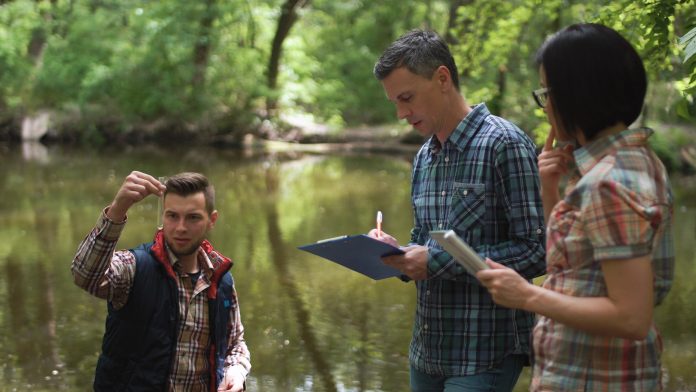Aside from having to deal with weather, mud, and the occasional slippery rock, there are key issues relating to sample quality that can make testing water specimens from the field a bigger challenge than lab testing. That is why when it comes to confidence and accuracy in on-site testing for nitrates, nitrites, phosphates, pH, and more, there’s nothing like using the right tools to do the job on the spot. Here is a quick checklist of trials, tribulations, and potential solutions for streamside sampling.
The challenges of lab-testing field samples
The focus of any testing protocol should be getting timely, reliable results in the most cost-effective manner. It is important to recognize, however, that collecting field samples for lab testing can impose additional layers of complexity on top of the basic test process:
- Maintaining sample quality from point-of-collection through to completed lab test can impose cumbersome restrictions on sample temperature and transport times or, worse, affect test outcomes if samples are mishandled.
- Days of lag time between sample collection and delivery of written lab results can delay positive action on troublesome findings.
- Inexperience with proper test protocols — especially within volunteer organizations — can limit what might reasonably be accomplished.
- Budget limitations can limit the scope or frequency of potential testing regimens.
Potential field-testing scenarios
Depending on the nature of the application, the best approach typically comes down to a specific balance of cost and speed versus confidence in the reliability and accuracy of test results.
Watershed organizations, for example, often rely on field-testing of streams, rivers, wells, and other watershed locations for long-term environmental monitoring. Their needs can range from monitoring baseline conditions and seasonal variations to pinpointing pollutant sources such as farms or industrial operations. The challenges these groups often face include limited funding and constant turnover of volunteers.
“We use volunteer-based monitoring as a means of working to protect or restore a specific tributary or the Delaware River watershed in general,” says Faith Zerbe, Director of Monitoring at Delaware Riverkeeper Network. “On-site monitoring can be focused on pipeline or natural gas infrastructure impacts, human health impacts, bacteria monitoring near public access areas, or nutrient monitoring to identify point-source or non-point-source issues.” Several examples Zerbe cites include concentrated-animal-feed-operation (CAFO) threats to the watershed and livestock impacts if grazing is happening in sensitive areas. “Monitoring results help us show how native stream buffers (vegetative plantings) and fences that keep cows out of streams help to improve water quality,” she explains.
Due to cost considerations across a large number of testing sites, Delaware Riverkeeper Network primarily trains its watchdog volunteers to use simple field kits to monitor nitrogen, phosphorus, dissolved oxygen, pH, and other water conditions for educational and “first-alert” applications. “We have also used a spectrophotometer for specific projects,” Zerbe notes, “and if we need better documentation for legal purposes we will use lab analysis or more accurate sampling to investigate further.”
Even laboratory-based water-test personnel within water treatment plants (WTPs) or wastewater treatment plants (WWTPs) occasionally require instant, on-demand field testing. A WTP might track water quality approaching its intake point, based on spills or accidents miles upstream. A WWTP might conduct forensic testing on selective branches of its sewer mains to isolate the inflow source of a specific pollutant that is affecting their treatment process.
Matching test options to outcome requirements
Short of instances that require third-party documentation for legal cases, multiple portable testing options offer cost-effective options to meet a progression of qualitative and quantitative field test needs. Where continuity of testing personnel is an issue, look for solutions designed for “minimally trained” operators.
- MQuant® Test Strips. Easy-to-use test strips for pH, ions, organic, and inorganic substances offer a quick way to identify qualitative results that confirm the presence or absence of a substance, on the spot, for as little as 10 cents per test.
- MQuant® Visual Tests. Self-contained test kits provide user friendly solutions for quantifying concentrations down to very low parts-per-billion (ppb) ranges, in just minutes, for less than US$1 per test.
- Instrumentation. Portable instruments are available to meet the highest level of user requirements at price points ranging from 30 cents up to US$3. Our small handheld RQflex20® reflectometer can provide precise on-site quantitative analysis for up to 35 parameters — including nitrates, nitrites, phosphates, pH, and more. Portable Spectroquant®colorimeters increase the number of testing protocols up to 100 different tests, and can increase the quantitative accuracy of critical parameters. More sophisticated spectrophotometers — about the size of a small desktop printer — make more than 200 Spectroquant® test parameters for drinking water, wastewater, and industrial process water as easy as direct insertion of a cell test vial.
Meeting test protocol demands
Whether a test protocol is new or well-established, assessing the circumstances behind it can go a long way toward identifying the most accurate, cost-effective field-testing solution.
- Focus/Accuracy. Does the application require a high degree of accuracy relative to small concentrations, or just a simple test for “presence/absence”? Are there serious consequences related to false-positive or false-negative readings?
- Sample Handling/Timing. Do special sample-handling issues cause concerns about quality of results? Is turnaround time for receiving test results critical?
- Operator Experience. Would task-specific instruments designed for minimally trained operators relieve concerns about test result reliability?
In addition to the types of tests and accuracy required, consider additional factors beyond the physical equipment and consumables. Compare cost-per-test based on consumables costs and frequency of testing, where an initial equipment investment could pay dividends in terms of thousands of quick and accurate tests over time. Finally, take into account the quality of calibration, quality control, and customer support the test equipment supplier can provide — including training videos, webinars, and one-on-one training conducted on-site or off-site.
For more information on our complete environmental testing workflow solutions, please visit:
SigmaAldrich.com/environmental-testing









